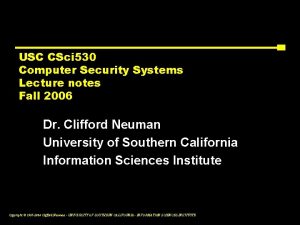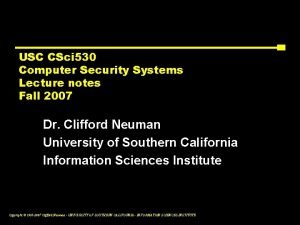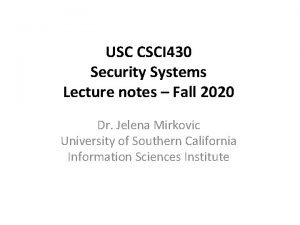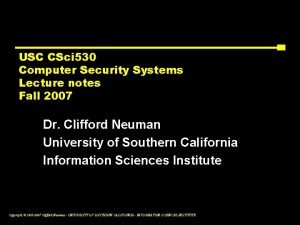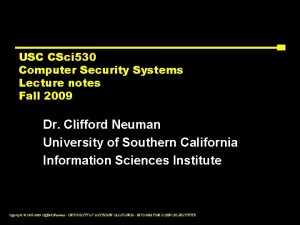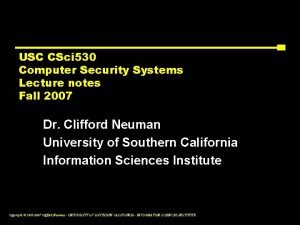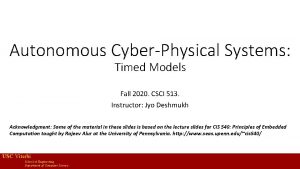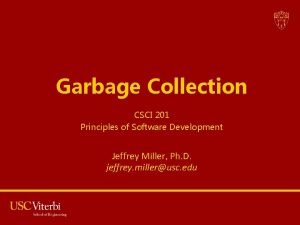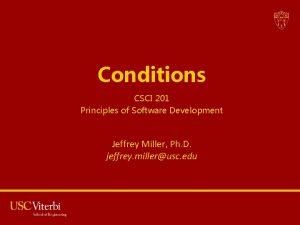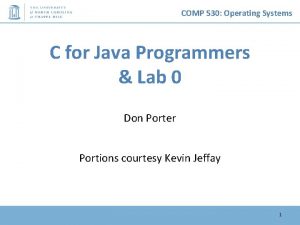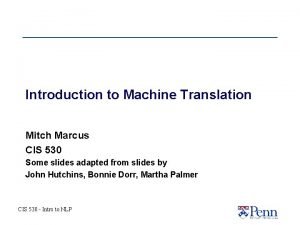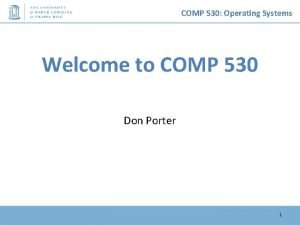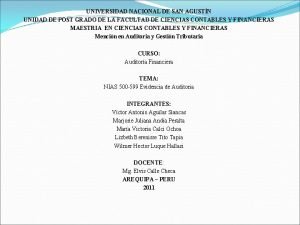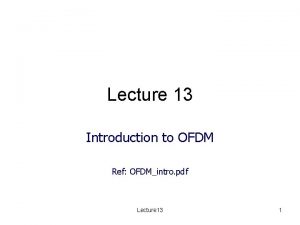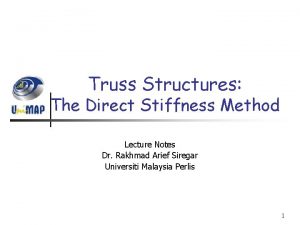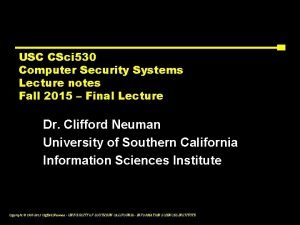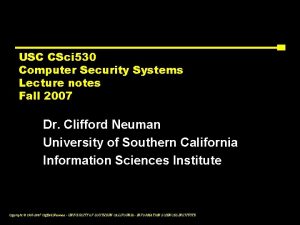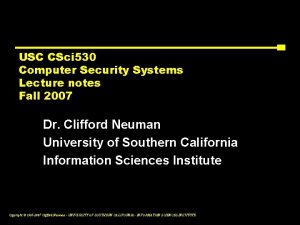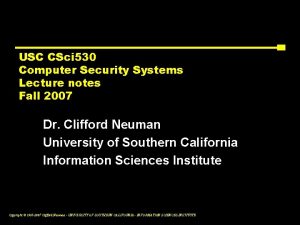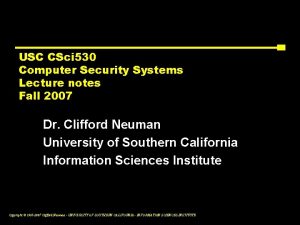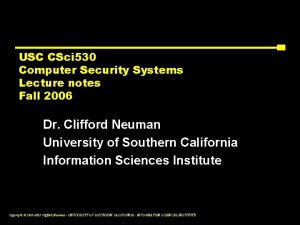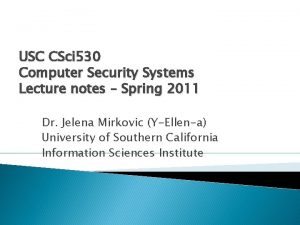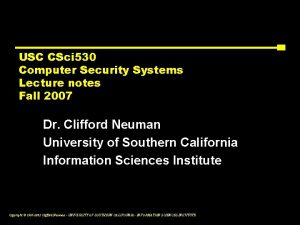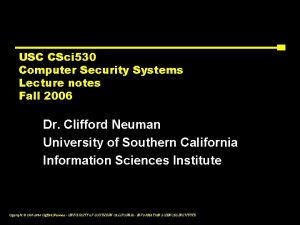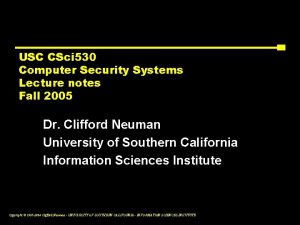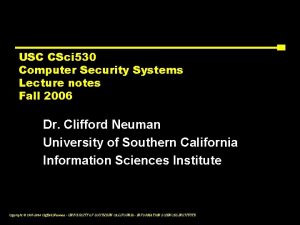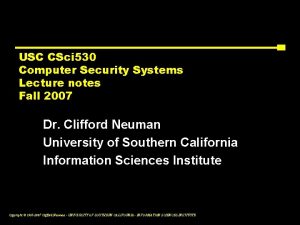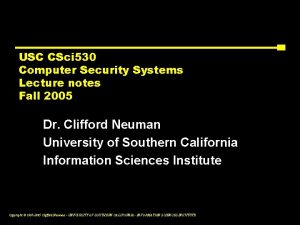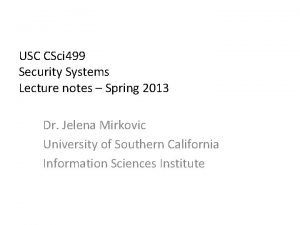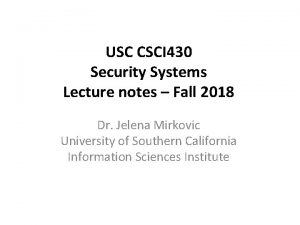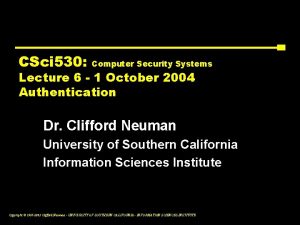USC CSci 530 Computer Security Systems Lecture notes





















































- Slides: 53

USC CSci 530 Computer Security Systems Lecture notes Fall 2007 Dr. Clifford Neuman University of Southern California Information Sciences Institute Copyright © 1995 -2007 Clifford Neuman - UNIVERSITY OF SOUTHERN CALIFORNIA - INFORMATION SCIENCES INSTITUTE

Announcements • Mid-term Grading Complete – Exam discussion today – Paper back at break. Copyright © 1995 -2007 Clifford Neuman - UNIVERSITY OF SOUTHERN CALIFORNIA - INFORMATION SCIENCES INSTITUTE

November 17 th and 18 th, 2007 SS 12 is a Code-A-Thon challenge: an opportunity for you to make a profound difference by developing innovative, empowering software projects for the disabled community, and win prizes for your work. Included: Meals and snacks for all participants SS 12 commemorative T-Shirts Prizes include: $1000 in cash 6 i. Pod Nanos Copies of Windows Vista and Office Microsoft Xbox and PS 2 games Custom painted skateboards You must register by Monday, November 11, 2007 Visit http: //ss 12. info for more information

CSci 530: Computer Security Systems Lecture 10 – 2 November 2007 Countermeasures and Detection Dr. Clifford Neuman University of Southern California Information Sciences Institute Copyright © 1995 -2007 Clifford Neuman - UNIVERSITY OF SOUTHERN CALIFORNIA - INFORMATION SCIENCES INSTITUTE

Mid-term review • Cryptography – Chaining for variation – Secondarily – small chunks • Matrix – Position – Preceding text – Predictability Copyright © 1995 -2007 Clifford Neuman - UNIVERSITY OF SOUTHERN CALIFORNIA - INFORMATION SCIENCES INSTITUTE 16

Mid-term review • PK Management – PGP – SSH – SSL – Diffie Helman Copyright © 1995 -2007 Clifford Neuman - UNIVERSITY OF SOUTHERN CALIFORNIA - INFORMATION SCIENCES INSTITUTE 16

Mid-term review • Mandatory Access Control – Biba is most helpful (integrity) – Bell-Lapadula less so (confidentiality) – More common systems? Copyright © 1995 -2007 Clifford Neuman - UNIVERSITY OF SOUTHERN CALIFORNIA - INFORMATION SCIENCES INSTITUTE 16

Mid-term review • Design Problems – Keys on USB Device – PIN or password for two factor ▪ (biometric possibly OK) – Counter-measure ▪ What gets signed Copyright © 1995 -2007 Clifford Neuman - UNIVERSITY OF SOUTHERN CALIFORNIA - INFORMATION SCIENCES INSTITUTE 16

FROM PREVIOUS LECTURE Firewalls • Packet filters – Stateful packet filters ▪ Common configuration • Application level gateways or Proxies – Common for corporate intranets • Host based software firewalls – Manage connection policy • Virtual Private Networks – Tunnels between networks – Relationship to IPsec Copyright © 1995 -2007 Clifford Neuman - UNIVERSITY OF SOUTHERN CALIFORNIA - INFORMATION SCIENCES INSTITUTE 16

FROM PREVIOUS LECTURE Packet Filter • Most common form of firewall and what one normally thinks of • Rules define what packets allowed through – Static rules allow packets on particular ports and to and from outside pairs of addresses. – Dynamic rules track destinations based on connections originating from inside. – Some just block inbound TCP SYN packets Copyright © 1995 -2007 Clifford Neuman - UNIVERSITY OF SOUTHERN CALIFORNIA - INFORMATION SCIENCES INSTITUTE 16

FROM PREVIOUS LECTURE Network Address Translation • Many home firewalls today are NAT boxes – Single address visible on the outside – Private address space (net 10, 192. 168) on the inside. • Hides network structure, hosts on inside are not addressable. – Box maps external connections established from inside back to the private address space. • Servers require persistent mapping and manual configuration. – Many protocols, including attacks, are designed to work through NAT boxes. Copyright © 1995 -2007 Clifford Neuman - UNIVERSITY OF SOUTHERN CALIFORNIA - INFORMATION SCIENCES INSTITUTE 16

FROM PREVIOUS LECTURE Application FW or Proxies • No direct flow of packets – Instead, connect to proxy with application protocol. – Proxy makes similar request to the server on the outsdide. • Advantage – Can’t hide attacks by disguising as different protocol. – But can still encapsulate attack. • Disadvantage – Can’t do end to end encryption or security since packets must be interpreted by the proxy and recreated. Copyright © 1995 -2007 Clifford Neuman - UNIVERSITY OF SOUTHERN CALIFORNIA - INFORMATION SCIENCES INSTITUTE 16

FROM PREVIOUS LECTURE Host Based Firewalls • Each host has its own firewall. – Closer to the data to be protected – Avoids the chewy on the inside problem in that you still have a boundary between each machine and even the local network. • Problems – Harder to manage – Can be manipulated by malicious applications. Copyright © 1995 -2007 Clifford Neuman - UNIVERSITY OF SOUTHERN CALIFORNIA - INFORMATION SCIENCES INSTITUTE 16

FROM PREVIOUS LECTURE Virtual Private Networks • Extend perimeter of firewalled networks – Two networks connected – Encrypted channel between them – Packets in one zone tunneled to other and treated as originating within same perimeter. • Extended network can be a single machine – VPN client tunnels packets – Gets address from VPN range – Packets encrypted in transit over open network Copyright © 1995 -2007 Clifford Neuman - UNIVERSITY OF SOUTHERN CALIFORNIA - INFORMATION SCIENCES INSTITUTE 16

FROM PREVIOUS LECTURE IPSec • IP Security (IPsec) and the security features in IPv 6 essentially move VPN support into the operating system and lower layers of the protocol stack. • Security is host to host, or host to network, or network to network as with VPN’s – Actually, VPN’s are rarely used host to host, but if the network had a single host, then it is equivalent. Copyright © 1995 -2007 Clifford Neuman - UNIVERSITY OF SOUTHERN CALIFORNIA - INFORMATION SCIENCES INSTITUTE 16

Attack Paths • Many attacks today are staged from compromised machines. – Consider what this means for network perimeters, firewalls, and VPN’s. • A host connected to your network via a VPN is an unsecured perimeter – So, you must manage the endpoint even if it is your employees home machine. Copyright © 1995 -2007 Clifford Neuman - UNIVERSITY OF SOUTHERN CALIFORNIA - INFORMATION SCIENCES INSTITUTE 16

Defense in Depth • One should apply multiple firewalls at different parts of a system. – These should be of different types. • Consider also end to end approaches – Data architecture – Encryption – Authentication – Intrusion detection and response Copyright © 1995 -2007 Clifford Neuman - UNIVERSITY OF SOUTHERN CALIFORNIA - INFORMATION SCIENCES INSTITUTE 16

Protecting the Inside • Firewalls are better at protecting inward threats. – But they can prevent connections to restricted outside locations. – Application proxies can do filtering for allowed outside destinations. – Still need to protect against malicious code. • Standalone (i. e. not host based) firewalls provide stronger self protection. Copyright © 1995 -2007 Clifford Neuman - UNIVERSITY OF SOUTHERN CALIFORNIA - INFORMATION SCIENCES INSTITUTE 16

Virus Checking • Signature based – Looks for known indicators in files – Real-time checking causes files to be scanned as they are brought over to computer (web pages, email messages) or before execution. – On server and client • Activity based – Related to firewalls, if look for communication – Alert before writing to boot sector, etc. • Defenses beyond just checking – Don’t run as root or admin Copyright © 1995 -2007 Clifford Neuman - UNIVERSITY OF SOUTHERN CALIFORNIA - INFORMATION SCIENCES INSTITUTE 16

CSci 530: Computer Security Systems Lecture 10 – 2 November 2007 Countermeasures and Detection Dr. Clifford Neuman University of Southern California Information Sciences Institute Copyright © 1995 -2007 Clifford Neuman - UNIVERSITY OF SOUTHERN CALIFORNIA - INFORMATION SCIENCES INSTITUTE

Intrusion Types • External attacks – Password cracks, port scans, packet spoofing, DOS attacks • Internal attacks – Masqueraders, Misuse of privileges Copyright © 1995 -2007 Clifford Neuman - UNIVERSITY OF SOUTHERN CALIFORNIA - INFORMATION SCIENCES INSTITUTE

Attack Stages • Intelligence gathering – attacker observes the system to determine vulnerabilities (e. g, port scans) • Planning – decide what resource to attack and how • Attack execution – carry out the plan • Hiding – cover traces of attack • Preparation for future attacks – install backdoors for future entry points Copyright © 1995 -2007 Clifford Neuman - UNIVERSITY OF SOUTHERN CALIFORNIA - INFORMATION SCIENCES INSTITUTE

Intrusion Detection • Intrusion detection is the problem of identifying unauthorized use, misuse, and abuse of computer systems by both system insiders and external penetrators • Why Is IDS Necessary? Copyright © 1995 -2007 Clifford Neuman - UNIVERSITY OF SOUTHERN CALIFORNIA - INFORMATION SCIENCES INSTITUTE

IDS types • Detection Method – Knowledge-based (signature-based ) vs behavior-based (anomaly-based) • Behavior on detection – passive vs. reactive • Deployment – network-based, host-based and application -based Copyright © 1995 -2007 Clifford Neuman - UNIVERSITY OF SOUTHERN CALIFORNIA - INFORMATION SCIENCES INSTITUTE

Components of ID systems • Collectors – Gather raw data • Director – Reduces incoming traffic and finds relationships • Notifier – Accepts data from director and takes appropriate action Copyright © 1995 -2007 Clifford Neuman - UNIVERSITY OF SOUTHERN CALIFORNIA - INFORMATION SCIENCES INSTITUTE

Advanced IDS models • Distributed Detection – Combining host and network monitoring (DIDS) – Autonomous agents (Crosbie and Spafford) Copyright © 1995 -2007 Clifford Neuman - UNIVERSITY OF SOUTHERN CALIFORNIA - INFORMATION SCIENCES INSTITUTE

Intrusion Response • Intrusion Prevention – (marketing buzzword) • Intrusion Response – How to react when an intrusion is detected Copyright © 1995 -2007 Clifford Neuman - UNIVERSITY OF SOUTHERN CALIFORNIA - INFORMATION SCIENCES INSTITUTE

Possible Responses – Notify administrator – System or network lockdown – Place attacker in controlled environment – Slow the system for offending processes – Kill the process Copyright © 1995 -2007 Clifford Neuman - UNIVERSITY OF SOUTHERN CALIFORNIA - INFORMATION SCIENCES INSTITUTE

Phase of Response (Bishop) – Preparation – Identification – Containment – Eradication – Recovery – Follow up Copyright © 1995 -2007 Clifford Neuman - UNIVERSITY OF SOUTHERN CALIFORNIA - INFORMATION SCIENCES INSTITUTE

PREPARATION • Generate baseline for system – Checksums of binaries ▪ For use by systems like tripwire • Develop procedures to follow • Maintain backups Copyright © 1995 -2007 Clifford Neuman - UNIVERSITY OF SOUTHERN CALIFORNIA - INFORMATION SCIENCES INSTITUTE

IDENTIFICATION • This is the role of the ID system – Detect attack – Characterize attack – Try to assess motives of attack – Determine what has been affected Copyright © 1995 -2007 Clifford Neuman - UNIVERSITY OF SOUTHERN CALIFORNIA - INFORMATION SCIENCES INSTITUTE

CONTAINMENT • Passive monitoring – To learn intent of attacker – Learn new attack modes so one can defend against them later • Constraining access – Locking down system – Closing connections – Blocking at firewall, or closer to source • Combination – Constrain activities, but don’t let attacker know one is doing so (Honeypots, Jail). Copyright © 1995 -2007 Clifford Neuman - UNIVERSITY OF SOUTHERN CALIFORNIA - INFORMATION SCIENCES INSTITUTE

ERADICATION • Prevent attack or effects of attack from recurring. – Locking down system (also in containment phase) – Blocking connections at firewall – Isolate potential targets Copyright © 1995 -2007 Clifford Neuman - UNIVERSITY OF SOUTHERN CALIFORNIA - INFORMATION SCIENCES INSTITUTE

RECOVERY • Restore system to safe state – Check all software for backdoors – Recover data from backup – Reinstall but don’t get re-infected before patches applied. Copyright © 1995 -2007 Clifford Neuman - UNIVERSITY OF SOUTHERN CALIFORNIA - INFORMATION SCIENCES INSTITUTE

FOLLOWUP • Take action against attacker. – Find origin of attack • Notify other affected parties – Some of this occurs in earlier phases as well • Assess what went wrong and correct procedures. • Find buggy software that was exploited and fix Copyright © 1995 -2007 Clifford Neuman - UNIVERSITY OF SOUTHERN CALIFORNIA - INFORMATION SCIENCES INSTITUTE

Limitations of Monolithic ID • • Single point of failure Limited access to data sources Only one perspective on transactions Some attacks are inherently distributed – Smurf – DDo. S • Conclusion: “Complete solutions” aren’t Copyright © 1995 -2007 Clifford Neuman - UNIVERSITY OF SOUTHERN CALIFORNIA - INFORMATION SCIENCES INSTITUTE

Sharing Information • Benefits – Increased robustness – More information for all components – Broader perspective on attacks – Capture distributed attacks • Risks – Eavesdroppers, compromised components Copyright © 1995 -2007 Clifford Neuman - UNIVERSITY OF SOUTHERN CALIFORNIA - INFORMATION SCIENCES INSTITUTE

Sharing Information • Communication risks can be resolved cryptographically (at least in part) • Defining appropriate level of expression – Efficiency – Expressivity – Specificity Copyright © 1995 -2007 Clifford Neuman - UNIVERSITY OF SOUTHERN CALIFORNIA - INFORMATION SCIENCES INSTITUTE

CIDF • Common Intrusion Detection Framework – Collaborative work of DARPAfunded projects in late 1990 s – Task: Define language, protocols to exchange information about attacks and responses Copyright © 1995 -2007 Clifford Neuman - UNIVERSITY OF SOUTHERN CALIFORNIA - INFORMATION SCIENCES INSTITUTE

CISL • Common Intrusion Specification Language – Conveys information about attacks using ordinary English words – E. g. , User joe obtains root access on demon. example. com at 2003 Jun 12 14: 15 PDT Copyright © 1995 -2007 Clifford Neuman - UNIVERSITY OF SOUTHERN CALIFORNIA - INFORMATION SCIENCES INSTITUTE

CISL • Problem: Parsing English is hard • S-expressions (Rivest) – Lisp-like grouping using parentheses – Simplest examples: (name value) pairs (Username ‘joe’) (Hostname ‘demon. example. com’) (Date ‘ 2003 Jun 12 14: 15 PDT’) (Action obtain. Root. Access) Copyright © 1995 -2007 Clifford Neuman - UNIVERSITY OF SOUTHERN CALIFORNIA - INFORMATION SCIENCES INSTITUTE

CISL • Problems with simple pairs – Confusion about roles played by entities ▪ Is joe an attacker, an observer, or a victim? ▪ Is demon. example. com the source or the target of the attack? – Inability to express compound events ▪ Can’t distinguish attackers in multiple stages • Group objects into GIDOs Copyright © 1995 -2007 Clifford Neuman - UNIVERSITY OF SOUTHERN CALIFORNIA - INFORMATION SCIENCES INSTITUTE

CISL: Roles • Clarifies roles identified by descriptors (Attacker (Username ‘joe’) (Hostname ‘carton. example. com’) (User. ID 501) ) (Target (Hostname ‘demon. example. com’) ) Copyright © 1995 -2007 Clifford Neuman - UNIVERSITY OF SOUTHERN CALIFORNIA - INFORMATION SCIENCES INSTITUTE

CISL: Verbs • Permit generic description of actions (Compromise (Attacker …) (Observer (Date ‘ 2003 Jun 12 14: 15 PDT’) (Program. Name ‘Gr. IDSDetector’) ) (Target …) ) Copyright © 1995 -2007 Clifford Neuman - UNIVERSITY OF SOUTHERN CALIFORNIA - INFORMATION SCIENCES INSTITUTE

Lessons from CISL • Lessons from testing, standardization efforts – Heavyweight – Not ambiguous, but too many ways to say the same thing – Mismatch between what CISL can say and what detectors/analyzers can reliably know Copyright © 1995 -2007 Clifford Neuman - UNIVERSITY OF SOUTHERN CALIFORNIA - INFORMATION SCIENCES INSTITUTE

Worm and DDOS Detection • Difficulty is distinguishing attacks from the background. – Zero Day Worms – DDo. S • Discussion of techniques – Honeynets, network telescopes – Look for correlation of activity Copyright © 1995 -2007 Clifford Neuman - UNIVERSITY OF SOUTHERN CALIFORNIA - INFORMATION SCIENCES INSTITUTE

CSci 530: Security Systems Lecture 12 – November 9, 2007 The Human Element ADVANCE SLIDES Dr. Clifford Neuman University of Southern California Information Sciences Institute Copyright © 1995 -2007 Clifford Neuman - UNIVERSITY OF SOUTHERN CALIFORNIA - INFORMATION SCIENCES INSTITUTE

The Human is the Weak Point • Low bandwidth used between computer and human. – User can read, but unable to process crypto in head. – Needs system as its proxy – This creates vulnerability. • Users don’t understand system – Often trust what is displayed – Basis for phishing Copyright © 1995 -2007 Clifford Neuman - UNIVERSITY OF SOUTHERN CALIFORNIA - INFORMATION SCIENCES INSTITUTE

The Human is the Weak Point(2) • Humans make mistakes – Configure system incorrectly • Humans can be compromised – Bribes – Social Engineering • Programmers often don’t consider the limitations of users when designing systems. Copyright © 1995 -2007 Clifford Neuman - UNIVERSITY OF SOUTHERN CALIFORNIA - INFORMATION SCIENCES INSTITUTE

Some Attacks • Social Engineering – Phishing – in many forms • Mis-configuration • Carelessness • Malicious insiders • Bugs in software Copyright © 1995 -2007 Clifford Neuman - UNIVERSITY OF SOUTHERN CALIFORNIA - INFORMATION SCIENCES INSTITUTE

Addressing the Limitations • Personal Proxies – Smartcards or devices • User interface improvements – Software can highlight things that it thinks are odd. • Delegate management – Users can rely on better trained entities to manage their systems. • Try not to get in the way of the users legitimate activities – Or they will disable security mechanisms. Copyright © 1995 -2007 Clifford Neuman - UNIVERSITY OF SOUTHERN CALIFORNIA - INFORMATION SCIENCES INSTITUTE

Much More Next Week Copyright © 1995 -2007 Clifford Neuman - UNIVERSITY OF SOUTHERN CALIFORNIA - INFORMATION SCIENCES INSTITUTE

Current Event Storm worm pulls Halloween hoax Dancing skeleton malware’s latest lure By Cara Garretson, Network World, 10/31/07 It wouldn’t be Halloween without the zombie-creating Storm malware up to some mischief. The latest Storm-backed spam campaign invites e-mail recipients to visit a Halloween-themed Web site where they can download a dancing skeleton. What gets downloaded instead is a version of the Storm malware that turns unsuspecting users’ PCs into members of the world’s largest botnet. Members of these botnets are also known as zombies. Copyright © 1995 -2007 Clifford Neuman - UNIVERSITY OF SOUTHERN CALIFORNIA - INFORMATION SCIENCES INSTITUTE
 Csci 530 security systems
Csci 530 security systems Csci 530 security systems
Csci 530 security systems Csci 430 usc
Csci 430 usc Csci 530 usc
Csci 530 usc Usc csci 530
Usc csci 530 Csci 530
Csci 530 Csci 513
Csci 513 Mark redekopp
Mark redekopp Csci 201 usc
Csci 201 usc Usc csci 201
Usc csci 201 01:640:244 lecture notes - lecture 15: plat, idah, farad
01:640:244 lecture notes - lecture 15: plat, idah, farad Operating system lecture notes
Operating system lecture notes Computer-aided drug design lecture notes
Computer-aided drug design lecture notes Computer architecture notes
Computer architecture notes Computer security 161 cryptocurrency lecture
Computer security 161 cryptocurrency lecture Security security security
Security security security Ece 530
Ece 530 Comp 530
Comp 530 Bioc 530
Bioc 530 Chinese to english translation
Chinese to english translation Comp 530
Comp 530 Nia 500 evidencia de auditoría
Nia 500 evidencia de auditoría Nep 630
Nep 630 530+450
530+450 Ece 530
Ece 530 Ece 530
Ece 530 Ar 530-1
Ar 530-1 Project procurement management lecture notes
Project procurement management lecture notes Theology proper lecture notes
Theology proper lecture notes Public sector accounting lecture notes in uganda
Public sector accounting lecture notes in uganda Project management notes
Project management notes Magnetism
Magnetism Physics 111 lecture notes
Physics 111 lecture notes Physical science lecture notes
Physical science lecture notes Power system dynamics and stability lecture notes
Power system dynamics and stability lecture notes Microbial physiology lecture notes
Microbial physiology lecture notes Mechatronics ppt
Mechatronics ppt Limits fits and tolerances lecture notes
Limits fits and tolerances lecture notes Financial engineering lecture notes
Financial engineering lecture notes Bjt
Bjt Requirement analysis in software engineering notes
Requirement analysis in software engineering notes Introduction to ofdm
Introduction to ofdm Land use planning lecture notes
Land use planning lecture notes Project management lecture notes doc
Project management lecture notes doc Lecture notes on homiletics
Lecture notes on homiletics Foundation engineering lecture notes
Foundation engineering lecture notes Image processing lecture notes
Image processing lecture notes Intermediate microeconomics lecture notes
Intermediate microeconomics lecture notes Parallel and distributed computing lecture notes
Parallel and distributed computing lecture notes Bayesian decision theory lecture notes
Bayesian decision theory lecture notes Nonlinear regression lecture notes
Nonlinear regression lecture notes Advanced inorganic chemistry lecture notes
Advanced inorganic chemistry lecture notes 50f7 tolerance
50f7 tolerance Direct stiffness method truss
Direct stiffness method truss
